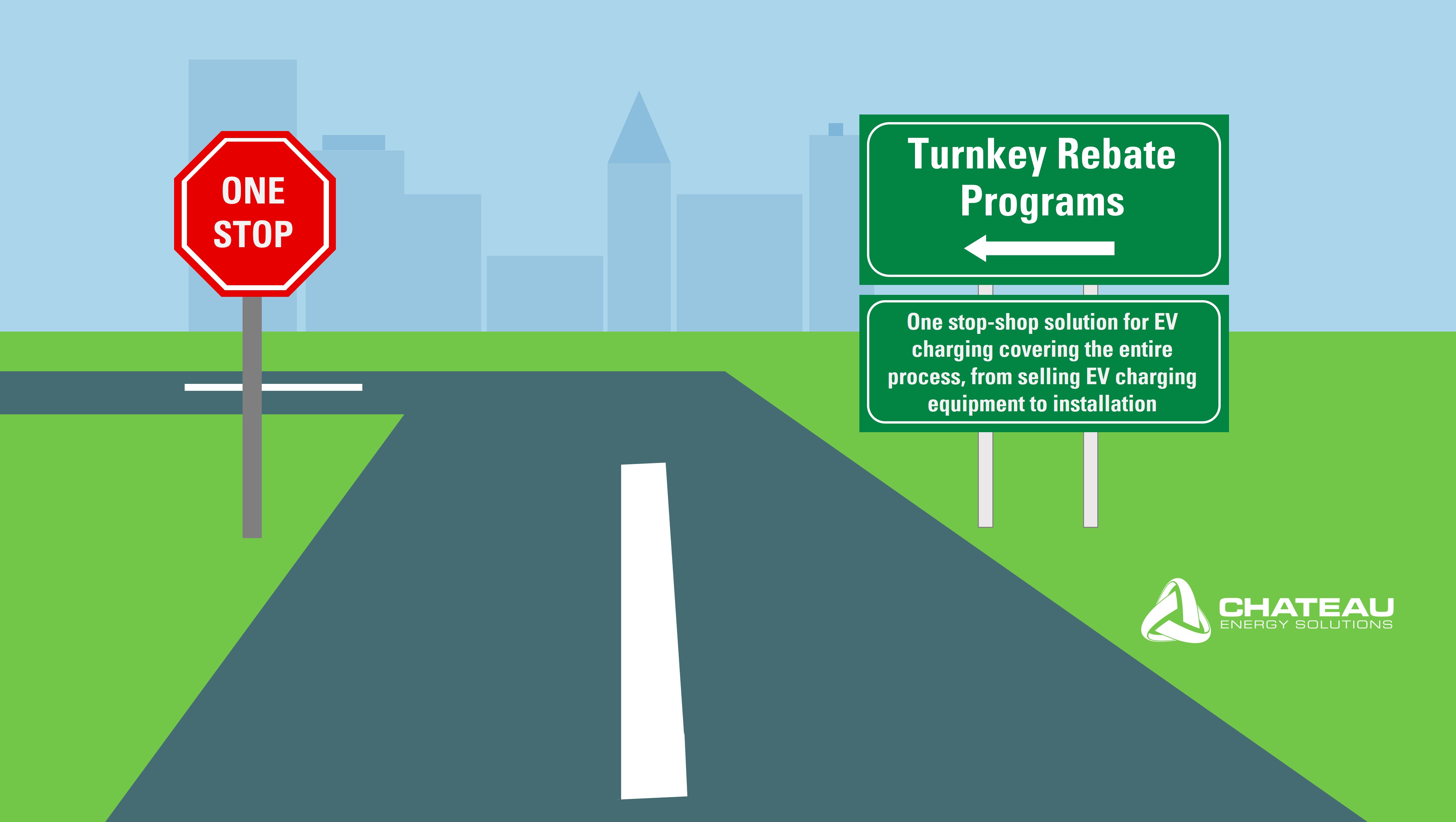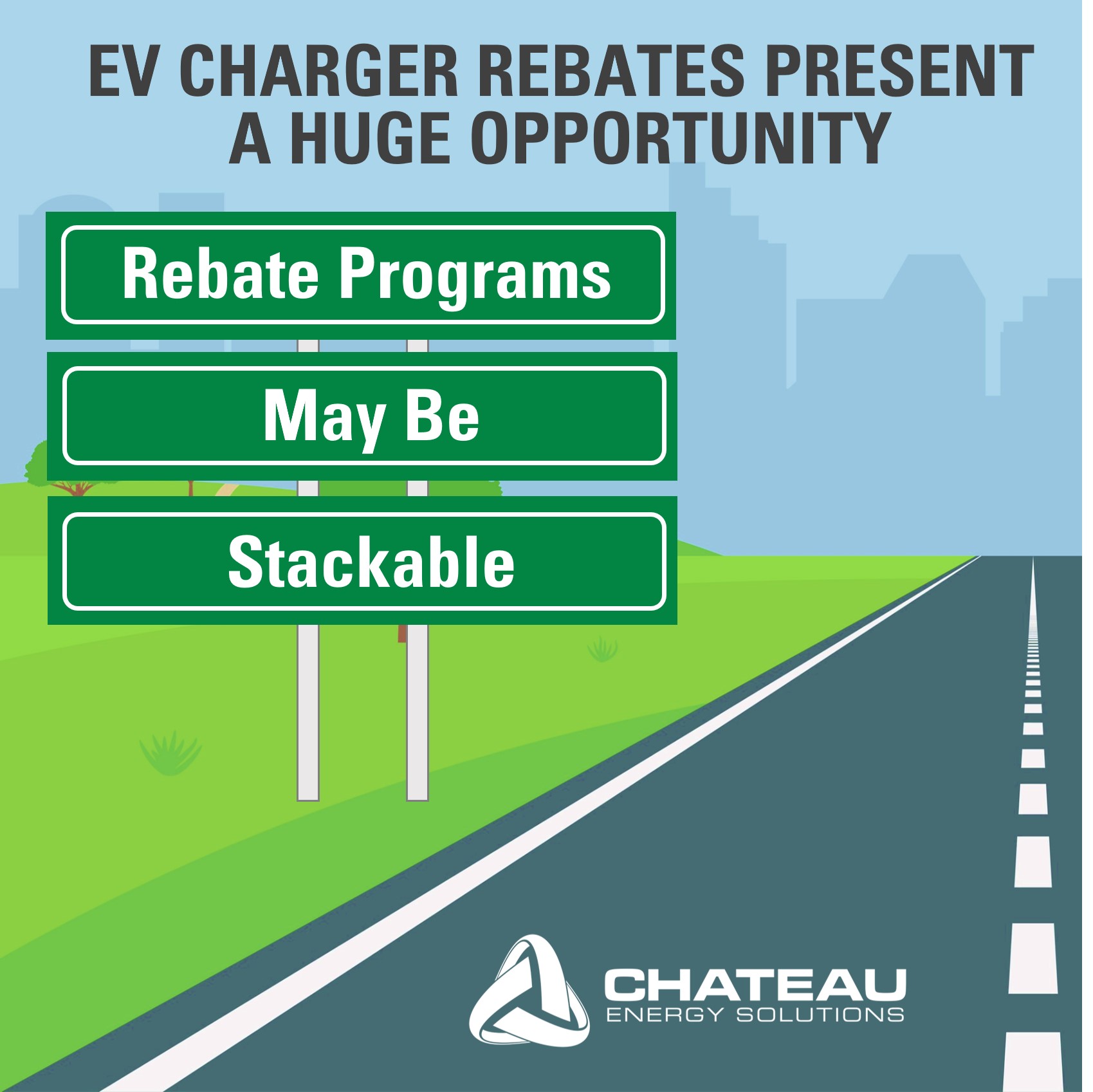
 Posted by Pam Hoddinott
Posted by Pam Hoddinott This blog explains the variety of rebates available with help from our partner at Briteswitch. EV Charger Rebates: Understanding the Different Types of Programs (briteswitch.com)
The interest in electric vehicle supply equipment (EVSE), or in more common terms EV chargers, has continued to grow at a high rate during the past couple of years. Rebates and incentives are crucial to the purchasing process of EV chargers. With nearly 500 active rebate programs in North America, it can be challenging to navigate. EVSE rebates are new and not as standardized as traditional energy efficiency rebates. This is causing it to be much more difficult for organizations to utilize EV charger incentives. By gaining insight into the various types of EV rebates available, organizations can lower the cost of transitioning their fleets to electric.
Electric vehicle chargers that are used to charge vehicles for multiple people and are connected to a commercial meter, commonly seen in multi-family locations or businesses, would want to consider a commercial EV rebate program.
You may have access to tax credits and grants for installing commercial electric vehicle charging stations. Both state and federal governments have implemented laws to offer incentives to businesses, aiming to support the establishment and upkeep of an electric vehicle market.
For example, in Georgia, the tax credit is for 10% of the cost of the charging station, up to $2,500. The electric utility company Georgia Power also offers commercial customers rebates for level 2 EV chargers. If installed between January 1, 2023, and December 31, 2023, customers can receive a $500 rebate per charger for up to five chargers.

Prescriptive rebates or standard rebates are the most common type of incentive for EV chargers. They currently make up 75% of the programs in the US. These incentives follow a prescribed or fixed dollar amount per product or unit purchased.
About half of the prescriptive rebates are paid per charger and about a third of these are paid by how many vehicles can connect to one charger (or per port). And remember, it’s important to get it pre-approved first. The rebate is normally offered as a check that the customer will receive 8-10 weeks post installation and after the final paperwork has been filed.
An example of a standard rebate is the New York State Electric Vehicle Charging Station Program. New York State provides rebates for the installation of Level 2 and DC fast charging stations through its Elective Vehicle Charging Station Program. The rebate amount is based on the charging station’s power level and location. In Massachusetts, they have the Massachusetts Electric Vehicle Incentive Program (MassEVIP) that also offers rebates based on the power level and charging station type.
Coming in as the second most common type of rebate program for EV chargers is the make-ready program. This program is quite different from energy efficiency incentives for retrofit projects. EVSE make-ready programs differ from perspective in that they cover a portion of the costs to make the site ready for the chargers.
These types of programs will differ depending on which aspects of the make-ready costs will be covered. Example being, some may only cover the utility-side aspects of make-ready, and some may include any of the make-ready costs all the way up to the charger connection.
You’re most likely going to see make-ready programs with Level 3 / DCFC (direct current fast charger) rebates, accounting for 15% of the total programs available. For make-ready programs, how you receive your rebate is going to be very similar to prospective rebates. They normally require pre-approval, and a check will be issued 8-10 weeks after the final application is submitted.
Georgia Power offers make-ready support to commercial customers installing charging stations. The Make-Ready Program assists in the development of charging infrastructure for a wide range of vehicles, including passenger vehicles, transit buses, forklifts, delivery trucks, and various other vehicle types.
On the East Coast, RG&E in New York will reimburse customers up to 50%, 90%, or 100% for utility-side infrastructure and customer-side infrastructure on eligible sites.
Point of purchase (POP), instant, or midstream rebates involve taking the incentive amount off at the point of purchase. Customers don’t have to wait for a check in the mail. Receiving the money immediately can help customers who are hesitant about switching to or installing commercial EV charging.
When it comes to EV chargers, the majority of these programs lean towards point-of-purchase (POP) or instant rebates. In these programs, a website is established, allowing customers to directly order chargers from the program without the need to submit any additional forms of paperwork.
In Colorado, there is a point-of-purchase rebate program for EV charging stations called “Charge Ahead Colorado”. It offers eligible businesses, multi-unit dwellings, and government entities the opportunity to receive instant rebates when purchasing EV charging equipment.
Right now, only a handful – 4% – of instant programs exist for EV chargers. They are mostly geared toward residential applications.
A turnkey rebate is a program that takes care of the entire process, from selling EV charging equipment to its installation, all under the program’s management. In simpler terms, it offers a comprehensive and effortless solution, overseeing every step to provide customers with a smooth experience. These programs are also sometimes referred to as “direct install” programs.
The primary objective of turnkey programs is to provide customers with a convenient, one-stop solution for charging installation. Under these programs, the installer subtracts the reb

An example of a commercial turnkey rebate program is CALeVIP or the California Electric Vehicle Infrastructure Project. CALeVIP implemented turnkey EV charger rebate programs across regions of California, providing support for commercial customers, including equipment procurement, installation, and operational support.
These programs tend to offer limited benefits to those in the electrical channel. These programs can create competition between electricians, distributors, and manufacturers who are all trying to serve customers in these areas. Turnkey programs represent only 3% of active programs currently available and are more common on the residential side.
Not every program has a rigid structure and falls into a specific category. Some programs determine incentives on a case-by-case or project basis. These programs can be competitive grants, or they can be programs that calculate the amount based on several factors. Some examples of factors are economic viability and overall cost of the project which can vary by location. With these rebates, it is very hard, nearly impossible, to calculate upfront, they can only be determined by going through the approval process. Case-by-case incentives are typically more prevalent for Level 3 / DCFC projects, representing 17% of the total rebates offered for these initiatives.
NEVI stands for “National Electric Vehicle Infrastructure Formula Program,” and is a popular topic in the industry. NEVI aims to help strengthen the fast-charging infrastructure across major national roadways. NEVI technically is a source of funding and not a different type of rebate. The rules and requirements of the program can change by state.
The federal government established specific program requirements, including the designation of Alternative Fuel Corridors and the mandate for open-access payment methods. Georgia’s NEVI planning for 2023 is allocated an estimated $28 million in funding (a 5-year program totaling $135 million), with 1,523 miles of EV charging corridors designated as either prepared or pending.

Certain projects can be combined, or “stacked”, using rebates from multiple sources. An example could be a utility creating a make-ready incentive to encourage customers to buy and commit to a Level 3/DCFC installation, and the state may provide an incentive for the equipment itself. It is important to remember even the combined rebates will never be more than the cost of the project itself.
Rebates play an important role in the sales process for people seeking to leverage the rapid expansion of the Electric Vehicle Supply Equipment sector. They serve as one of the most effective sales tools to incentivize customers and drive them to proceed with their projects. EV charging is here, and it is here to stay, but some organizations need a little extra motivation to make the transition or begin the process.
With 74% coverage of the United States currently offering rebates or incentives for EV chargers, there exists a massive amount of opportunity in this space. Although these programs may be more complicated than conventional energy efficiency rebates, investing time to really understand the available programs and how they work is worthwhile.
Chateau Energy Solutions’ expert team is ready to assist you in implementing EV infrastructure and charging solutions for your organization. We provide a comprehensive turnkey EV deployment service, and our skilled professionals are highly experienced in navigating the complex landscape of rebates and incentives.
Interested in learning more about EV charger rebates? See our blog Three Trends in EV Charger Rebates.
Mason Lassiter is a dynamic Marketing Associate with a passion for creativity and a relentless drive for results. He is an Atlanta native and a graduate of the University of South Carolina with a communications degree in Public Relations. As part of the Chateau Energy Solutions team, Mason’s mission is to craft compelling marketing strategies that captivate audiences and drive business growth. Beyond the office, Mason enjoys golfing, personal fitness, and attending any Atlanta sports team’s game. Contact Mason on LinkedIn.
Chateau Energy Solutions Making Energy an Asset®
Ready to get started on the path to energy efficiency and sustainability?